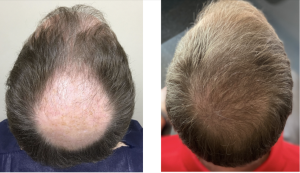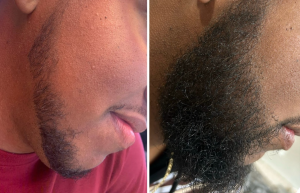Are you looking for a hair transplant surgeon? If so, you’re probably reading online reviews to get an idea of the surgeon’s ability to accomplish results that meet patient expectations. If you’ve been reading reviews for Dr. Marco Barusco – Founder and Chief Medical Officer at Tempus Hair Restoration – you’ve seen numerous five-star ratings and enthusiastic, heartfelt accounts of each patient’s experience. But what is the story behind their reviews? Two of Dr. Barusco’s patients offered to speak at length about their hair restoration journey – and why they were glad they chose him to achieve their goal.
Kevin Geddings – Owner of WSOS Radio and Morning Show Host, St. Augustine, FL
When Kevin Geddings started losing hair in his early 20s, he wasn’t surprised that it was from his crown area. “Balding in the crown is common in my family,” he said. “It’s just what’s expected. So that was my area of concern in seeking a hair transplant.”
Because radio personalities aren’t known for being introverts, his friends and associates never suspected that self-confidence was an issue. But his bald spot was an always-present, unwanted family legacy. When Geddings decided to look into his hair restoration options, Dr. Barusco was the first – and only – surgeon he consulted.
“One thing that impressed me is that the initial consultation was not rushed,” Geddings said. “Typically with a doctor, their time is very limited, and you feel they want to move things along. But Dr. Barusco talked at length with me during the consultation. We talked about hair growth patterns and how he figures that into the procedure to achieve a natural-looking result. We also talked very openly about pain management.
“Additionally, Dr. Barusco is on the faculty of the UCF medical school, which says a lot about his credentials. Also, it’s rare to work with a surgeon who’s actually had the experience of having a hair transplant. He just inspired a lot of confidence.”
In discussing the plan for Geddings’ procedure, Dr. Barusco determined he was a good candidate for the Follicular Unit Transplantation (FUT). Also known as the “strip” method, the FUT procedure has undergone refinements over the years so that the only evidence is a pencil-line linear scar easily concealed by hair – even at a shorter length.
During the surgery, Geddings reported a comfortable, pain-free experience. Especially noteworthy to him was the presence of other surgeons and doctors who were there to observe Dr. Barusco in order to perfect their own technique.
“For me, that was a key indication of his skill level,” Geddings said.
After many years of living with a bald crown, Geddings started seeing new growth in three to four months post-op.
“When I first saw the new growth, I thought it was very exciting. I was very pleased that I made the decision to do it. As Dr. Barusco will tell you, your hair will go through a shock, and you’ll lose the new hair. But it starts to grow again after. The result started to be most noticeable after nine months. I had a follow-up exam, and Dr. Barusco told me that he thought I could get even better results with a second surgery, since I still had plenty of inventory [donor hair] that we could utilize.”
Geddings underwent the second procedure in 2019 – about one year and a half after the first – happy that Dr. Barusco was able to harvest even more hair follicles from his donor area than during the original surgery. Today, Geddings is still thrilled that through the skill and artistry of Dr. Barusco he was able to reverse the family curse of a bald crown. In fact, Dr. Barusco has been a frequent guest on his radio show.
“Dr. Barusco is one of the best hair transplant surgeons in the world, if not the best, yet he genuinely enjoys getting to know his patients. He’s incredibly laid-back, and has a great personality. You won’t feel intimidated. After my surgeries, he called me on his cell phone at 8 p.m. to see how I was doing. It’s pretty rare that the actual surgeon will check in on you hours after the procedure.”

Kevin Geddings: Before and After Crown Area FUT Hair Transplant
Geddings’ advice for men considering a hair transplant?
“Don’t delay. A lot of guys think this is going to be inconvenient or painful. These are excuses with no basis in fact. It wasn’t painful at all. I didn’t even take the prescription pain medication. I was right back to work on the radio the next day. Forget the old-school misconceptions of what transplants were back in the ‘90s. The results are really, really good!
“My biggest regret is that I should have done it years ago. If you’re thinking about a hair transplant, stop procrastinating. You’re not gaining anything by waiting.”
Argelis F. – Making the Dream of a Full Beard Come True
In his online review on RealSelf, Argelis F. shared the story of his beard transplant by Dr. Barusco, and the life-changing effect it’s had.
Argelis wanted a beard ever since he was old enough to grow one. However, nature didn’t cooperate.
“I only had upper cheek patches,” he said. “The only thing that truly grew in was the line of the jaw, but I had always wanted fullness. Ironically, my brother was able to grow out a full beard.”
Although frustrated by his inability to grow a burly beard, Argelis had the financial responsibilities typical of a husband and father of four children. Yet he never lost sight of his dream, and eventually saved enough money through working overtime to look for a hair transplant surgeon.
“I called plenty of other surgeons,” Argelis said. “But his was the only practice I called where I spoke to the doctor himself. With the other places, I never got the actual procedure explained to me by the doctor. It was always by somebody else in the office. But Dr. Barusco was different.”
Argelis had a video consultation with Dr. Barusco. The appointment was scheduled after Argelis sent Dr. Barusco photos of his face as it was, and with a line drawn to indicate the areas where he wanted growth. During the consultation, he was surprised that Dr. Barusco wanted to see the back of his head, from where the donor hair would be harvested. Argelis hadn’t considered that Dr. Barusco would want to make sure that enough good-quality hair would be available to give him the coverage he wanted – and was impressed with Dr. Barusco’s attention to such an important detail.
“The way Dr. Barusco explained everything made me very comfortable. It was an excellent conversation. I could tell he has experience.”
On the big day, Argelis reported a very comfortable experience during surgery, which was performed under local anesthesia. He enjoyed lunch during a break in the procedure, then drifted back into relaxed sleep.
“There was no pain, even afterwards. It was almost like it didn’t happen.”
But just over two weeks later, Argelis began to see the proof that it really did happen.
“I believe that after the second week, I was able to scrub my face. I saw hair. Dr. Barusco told me not to be discouraged if I didn’t see anything after the scabs fell off, but six or seven months in, there was growth!”
It was a proud day for Argelis when he went to the barber to trim his beard and even it up. “It looks so natural, I don’t tell people I had the procedure done.”
Argelis said he appreciates Dr. Barusco’s technical skill and artistry, based upon the reactions he’s received – as well as the poor results he’s seen of beard transplants performed by other surgeons. He told of seeing a man he’d known for a long time who remarked on his beard. The man assumed Argelis had just decided to grow a beard – as if he’d always had the ability, but simply chosen not to do so until recently. Argelis did not correct him.
On another occasion, he went to a restaurant with his father-in-law, who knew someone who worked there. His father-in-law told Argelis the man had a beard transplant. “He went overseas for the transplant. It had been some time since he had it done, but he still had patchy growth and some red areas on his skin.”

Argelis: Before and After Beard Transplant
What advice does Argelis have for men considering a beard transplant?
“Don’t go for the cheaper things in life. You get what you pay for. If you want a beard that looks natural, you need a good surgeon. I left the review for Dr. Barusco because I’m truly happy with the result. To me, this is life-changing. I feel more comfortable as a man. I want people to know that this is worth it. The person I went to is the real deal.”
Read the Reviews to Help You Choose Your Surgeon Wisely
We at Tempus Hair Restoration thank every patient who has placed their trust in Dr. Barusco to perform their hair transplant procedure. Taking the time to write a review or agree to appear in a testimonial video on Dr. Barusco’s YouTube Channel – Hair Loss Medical Advice – means a great deal to us. You have helped others get the information they need to make an informed choice about an extremely important decision.
Ultimately, we want those considering a hair transplant to choose your surgeon based on experience, results and integrity. Dr. Barusco’s long list of accomplishments, his notable artistic ability and his successful surgical team make Tempus Hair Restoration a renowned practice. We understand that the main concern you may have is cost, which is why we offer financing options that can place this important goal within reach.
Contact us to schedule your free virtual consultation. Dr. Barusco conducts every consultation himself, giving you the opportunity to learn your options in the comfort of your home – or any location, on any internet-enabled device.
Dr. Barusco conducts consultations in English, Spanish and Portuguese. For your greater convenience, Tempus Hair Restoration offers a two-night complimentary hotel stay to out-of-town clients who travel 100 miles or more to our Port Orange, Florida, surgical center. No matter how far the distance, we welcome the opportunity to help you on your hair restoration journey!

